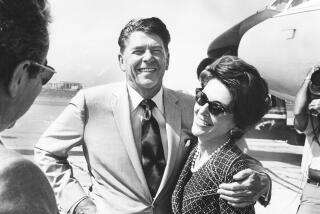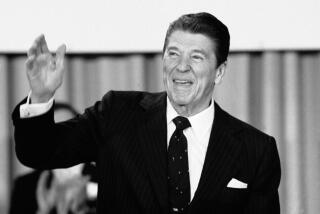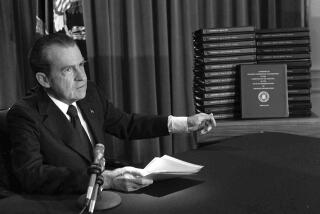The Reagan Comeuppance on Capitol Hill : Administration Misreads Public
WASHINGTON â This weekâs congressional decisions marked an extraordinary event: Ronald Reaganâs so-called tax reform, his second-term priority, was derailed; meanwhile the Gramm-Rudman deficit-reduction bill was passed--in a form the President considered vetoing because of its tax-increase and defense reduction implications.
Rarely does Congress impose its own economic policy judgments on a President enjoying close to 70% popularity. Yet the House and Senate actions represent a realistic appraisal of the political and economic unacceptability of the bold âSecond American Revolutionâ ambitions Reaganites laid out a year ago, in the wake of the 1984 landslide.
Let me be blunt. The Presidentâs tax reform and Gramm-Rudman embarrassments are part-and-parcel of a fundamental miscalculation. As recently as last winter, ambitious Reagan aides gloried in the 1984 election--for them it signaled political and ideological realignment. They felt voters had endorsed a new GOP era--encompassing deregulation, dismantling federal domestic programs, upholding free trade and minimally restricting foreign product access to U.S. markets, phasing out assistance to agriculture and slashing tax brackets.
Yet the 1984 elections never signaled any such demand: The public has opposed many parts of the resultant Reagan blueprint and been apathetic to the rest. Former budget director David A. Stockman is said to be titling his forthcoming book, âThe Triumph of Politics: Why the Reagan Revolution Failed.â A better title would be âThe Misunderstanding of Politics.â Thatâs what happened. What the President and his advisers wanted never had inadequate roots in political reality.
White House embarrassment over congressional stalling of its tax overhaul hopes and its discomfort with Gramm-Rudmanâs deficit-reduction machinery should be viewed as part of this larger failing. Tribulations began almost immediately last winter, when Congress slashed the Presidentâs request for 5%-6% real growth in the defense budget and used the savings to fund domestic programs that the White House sought to abolish. That should have been a signal. How Reaganites ever thought these priorities could succeed bewildered congressional Republicans from the start. Many declared the Presidentâs budget âdead on arrivalâ at Capitol Hill.
The timing of Reaganite demands for free-market agriculture also strained credulity. Early this year, the Administration sought to eliminate most federal farm aid, ignoring the pathos and political backlash of a farm belt in the worst slump since the Great Depression. Not surprisingly, with farmland prices plummeting 22% over the last 12 months in the Chicago Federal Reserve District--and with headlines about distraught farmers shooting bankers--Congress has declined to go along.
Yet the three areas where the early 1985 Reagan blueprint has been farthest off the mark are clear: the budget, taxes and trade. National surveys on these issues showed the President drawing just 37%-38% approval, far below his high (and perhaps not very relevant) 65%-70% personal approval rating.
The common denominator of these fumbles is evident: a mixture of excessive White House ideological commitment to a laissez-faire economy combined with a lack of electoral savvy and sound political strategy. Until an insurrectionist Congress developed the Gramm-Rudman mandatory deficit reduction mechanism, the Administrationâs attitude toward the deficit was often both naive and Machiavellian. On one hand, the White House brandished complaints about the deficit, to force Congress to cut domestic spending. Meanwhile, the President pressed for more military spending and tax-bracket reduction instead of a tax increase.
To use a favorite phrase, Gramm-Rudman now reorders these priorities. Although the President endorsed the legislation, some of his advisers--Defense Secretary Casper W. Weinberger, most prominently--urged him to veto it. Defense will bear roughly half the burden if the mandatory spending-cut mechanisms come into play.
The second Reagan insistence jeopardized by Gramm-Rudman is no tax increase . Indeed, the âdoomsday machineâ process by which Gramm-Rudman would decimate domestic spending virtually guarantees that Congress will try to substitute a tax increase for some of the cuts. Farm-sector legislators are already grumbling about rural disaster and National League of Cities spokesmen have evoked the specter of urban riots.
All this underscores the strategic naivete of proposing--as the President did last spring--a grand, high-priority effort to reduce tax brackets and restructure the federal tax code by eliminating many popular deductions--but without raising additional revenue. Itâs poor politics to ease upper-income individual and corporate tax brackets while simultaneously slashing rural and urban aid programs. More to the point, summer and fall surveys have shown the public cool to the idea of buying bracket reduction at the cost of surrendering or modifying such popular tax breaks as deducting state and local taxes and mortgage interest, as well as tax-free employee health benefits.
The Administration chose to disregard public opinion and propose such a trade-off--popular deductions in exchange for lower brackets (mostly at the top)--because aides were captivated by a free-market vista. Conservatives have always thrilled to the notion of creating an unbiased low-rate system, where economic decisions would reflect markets, not tax decisions. Political âpipe dreamâ best describes it though, and, over the last few months, the White House has paid the inevitable price, as Democrats in the House transformed the program. They restored popular tax breaks for individuals at the expense of business--in a way that was entirely predictable--but this offended House Republicans to the point of causing last weekâs surprise revolt.
Trade is the third category in which the Administrationâs original early 1985 policy has been shown up as something from laissez-fairyland. Back in February, the President hailed the soaring U.S. dollar as a patriotic achievement, all but humming a new economic stanza to âThe Star-Spangled Banner.â The markets would rule, Reaganites said. And cheap imports were a boon to the public.
These assumptions collapsed last summer, and in late September the Administration--belatedly, to head off a Congressional revolt--launched crash programs to devalue the dollar and toughen U.S. trade policy. Yet current surveys show that the public and businessmen alike remain skeptical. Experts now worry that next yearâs U.S. trade deficit with Japan will be bigger than this yearâs. Moreover, when the President vetoes, as he is sure to, the over-ambitious textile, shoe and copper protectionist legislation recently passed by a 60% majority in both Houses of Congress, he all but guarantees passage of further strong, if probably wiser, trade legislation early next year.
No reelected president has so badly misjudged congressional and public opinion on important economic issues in the first year of his new term. Reagan and the Republican Party have probably paid a substantial price--the former in historical assessment, the latter in electoral opportunity. Moreover, the piecemeal transformation of U.S. economic policy can hardly be said to be safely completed. Some of Washingtonâs coolest political heads are calling Gramm-Rudman a procedural disaster that may well backfire before the end of 1986. Nevertheless, Congress deserves some tolerance for repackaging, under fire, one of the more poorly thought out White House economic strategies in memory.
More to Read
Get the L.A. Times Politics newsletter
Deeply reported insights into legislation, politics and policy from Sacramento, Washington and beyond. In your inbox three times per week.
You may occasionally receive promotional content from the Los Angeles Times.










